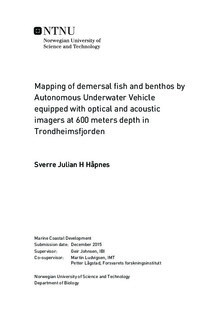Mapping of demersal fish and benthos by Autonomous Underwater Vehicle equipped with optical and acoustic imagers at 600 meters depth in Trondheimsfjorden
Master thesis
Permanent lenke
http://hdl.handle.net/11250/2374242Utgivelsesdato
2015Metadata
Vis full innførselSamlinger
- Institutt for biologi [2613]
Sammendrag
The marine environment is largely under-sampled both in time and space. There is a growing need for more automated approaches to provide a better understanding, identification, mapping and monitoring of biogeochemical processes for future environmental management of biological resources present in or around the seafloor. This thesis aims at identifying and mapping demersal fish and benthos by means of an autonomous underwater vehicle (AUV) for establishing non-invasive measurements on abundance of fish and benthos. Future prospects include implementing these findings for future nature management and decision-making. A soft bottom community compiling demersal fish and benthos in the Agdenes deep water basin was surveyed using the HUGIN HUS AUV at a depth of approximately 600 m. Imagery provided by a photomosaic camera (high spatial resolution) and a synthetic aperture sonar (high spatial coverage) covering 39 200 m2 of seafloor were used for identification and mapping biological objects of interest (OOI). The findings indicates relatively high abundance of Herring smelts (Argentinidae spp.) and Rabbit fish (Chimaera monstrosa) and a wide spread distribution of other demersal fish species. Benthos, including sea stars, anemones and crabs, were relatively numerous. The sonar provided imagery of high spatial coverage, but the spatial resolution was considered to be too low for detection of biological OOI under present conditions. The photomosaic camera provided imagery of high spatial resolution enabling identification of fish species and other benthos to family or order. The AUV is considered to be a suitable tool for mapping biological habitats, being an efficient and adaptable platform for surveying features of biological significance.
